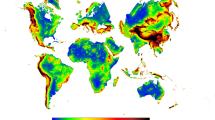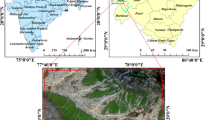Abstract
The calculation of slope (downhill gradient) for a point in a digital elevation model (DEM) is a common procedure in the hydrological, environmental and remote sensing sciences. The most commonly used slope calculation algorithms employed on DEM topography data make use of a three-by-three search window or kernel centered on the grid point (grid cell) in question in order to calculate the slope at that point. A comparison of eight such slope calculation algorithms has been carried out using an artificial DEM, consisting of a smooth synthetic test surface with various amounts of added Gaussian noise. Morrison's Surface III, a trigonometrically defined surface, was used as the synthetic test surface. Residual slope grids were calculated by subtracting the slope grids produced by the algorithms on test from true/reference slope grids derived by analytic partial differentiation of the synthetic surface. The resulting residual slope grids were used to calculate root-mean-square (RMS) residual error estimates that were used to rank the slope algorithms from “best” (lowest value of RMS residual error) to “worst” (largest value of RMS residual error). Fleming and Hoffer’s method gave the “best” results for slope estimation when values of added Gaussian noise were very small compared to the mean smooth elevation difference (MSED) measured within three-by-three elevation point windows on the synthetic surface. Horn’s method (used in ArcInfo GRID) performed better than Fleming and Hoffer’s as a slope estimator when the noise amplitude was very much larger than the MSED. For the large noise amplitude situation the “best” overall performing method was that of Sharpnack and Akin. The popular Maximum Downward Gradient Method (MDG) performed poorly coming close to last in the rankings, for both situations, as did the Simple Method. A nonogram was produced in terms of standard deviation of the Gaussian noise and MSED values that gave the locus of the trade-off point between Fleming and Hoffer’s and Horn’s methods.
Similar content being viewed by others
References
N.C. Barford. Experimental Measurements: Precision, Error and Truth, Addison-Wesley Publishing Company: London, 32, 1967.
P.A. Burrough. Principles of Geographical Information Systems for Land Resources Assessment, Clarendon Press: Oxford, 50, 1986.
J. Dozier and A.H. Strahler. “Ground investigations in support of remote sensing,” Manual of Remote Sensing, Vol. 1, R.N. Colwell (Ed.), Falls Church, Virginia: American Society of Photogrammetry, 1983.
EPPL, “Environmental planning and programming language user's guide,” Minnesota State Planning Agency, St Paul, MN, 1987.
ESRI, “ARC/INFO User's Guide,” GRID Command References, Environmental Systems Research Institute, Inc., Redlands, CA, 1995.
I.S. Evans. “An integrated system of terrain analysis for slope mapping,” Zeitschrift fur Geomorphologie, Vol. 36:274, 1980.
M.D. Fleming and R.M. Hoffer. “Machine Processing of Landsat MSS Data and DMA Topographic Data for Forest Cover Type Mapping,” Laboratory for Applications of Remote Sensing, Purdue University, West Lafayette, IN, LARS Technical Report 062879, 1979.
M.E. Hodgson. “What cell size does the computed slope/aspect angle represent?,” Photogrammetric Engineering and Remote Sensing, Vol. 61-5:513–517, 1995.
B.K.P. Horn. “Hill shading and the reflectance map,” Proceedings of the IEEE, Vol. 69-1:14–47, 1981.
M. Hsu and A.H. Robinson. The Fidelity of Isopleth Maps, University of Minnesota Press: Minneapolis, MN, 17, 1970.
M.F. Hutchinson. “A new procedure for gridding elevation and stream line data with automatic removal of spurious pits,” J. Hydrol, Vol. 106:211–232, 1989.
K.H. Jones. (an invited submission for a special issue of Computers and Geosciences). A Comparison of Algorithms used to Compute Hill Slope as a Property of the DEM.
H. Mitasova and L. Mitas. “Interpolation by regularized spline with tension: I. Theory and implementation,” Mathematical Geology, Vol. 25-6:641–655, 1993.
I.D. Moore, R.B. Grayson, and A.R. Ladson. “Digital terrain modelling: A review of hydrological, geomorphological and biological applications,” Hydrological Processes, Vol. 5:3–30, 1991.
J.L. Morrison. “Method-Produced Error in Isarithmic Mapping,” American Congress on Surveying and Mapping, Washington, D.C., Technical Monograph No. CA-5, 24, 1971.
J. Neter and W. Wasserman. Applied Linear Statistical Models, Irwin: IL, 1974.
G. Onorati and M. Poscolieri. “The Italian mean heights archive, a digital data set useful for thematic mapping and geomorphological units analysis,” in Proc. 8 th Symposium EARSeL, Capri, Italy, 451–466, 1988.
P. Ritter. “A vector-based slope and aspect generation algorithm,” Photogrammetric Engineering and Remote Sensing, Vol. 53-8:1109–1111, 1987.
D.A. Sharpnack and G. Akin. “An algorithm for computing slope and aspect from elevations,” Photogrammetric Engineering, Vol. 35-3:247–248, 1969.
A.K. Skidmore. “A comparison of techniques for calculating gradient and aspect from a gridded digital elevation model,” Int. J. Geographical Information Systems, Vol. 3-4:323–334, 1989.
M.R. Travis, G.H. Elsner, W.D. Iverson, and C.G. Johnson. “VIEWIT Computation of Seen Areas, Slope and Aspect for Land-use Planning,” US Dept. of Agriculture Forest Service Gen, Pacific Southwest Forest and Range Experimental Station, Berkley, CA, Techn. Rep. PSW 11/1975, 1975.
D. Unwin. Introductory Spatial Analysis, Methuen & Co: London, 167–168, 1981.
J.W. Wood. “The Geomorphological Characterisation of Digital Elevation Models,” Ph.D. Dissertation, Department of Geography, University of Leicester, Leicester, U.K.
L.W. Zevenbergen and C.R. Thorne. “Quantitative analysis of land surface topography,” Earth Surface Processes and Landforms, Vol. 12:47–56, 1987.
Author information
Authors and Affiliations
Rights and permissions
About this article
Cite this article
Jones, K.H. A Comparison of Two Approaches to Ranking Algorithms Used to Compute Hill Slopes. GeoInformatica 2, 235–256 (1998). https://doi.org/10.1023/A:1026472421094
Issue Date:
DOI: https://doi.org/10.1023/A:1026472421094




